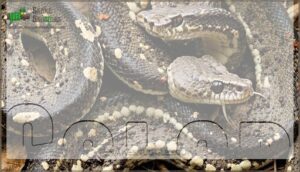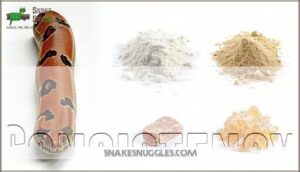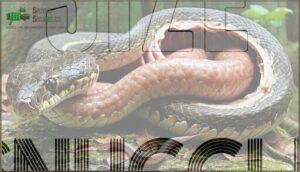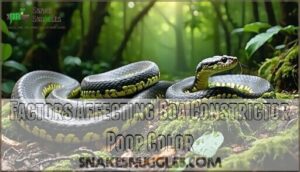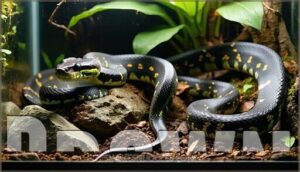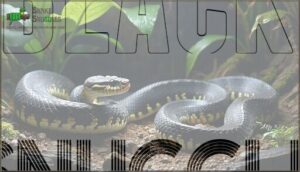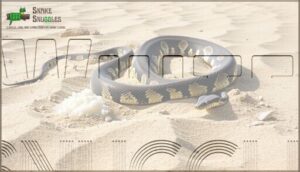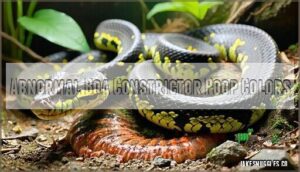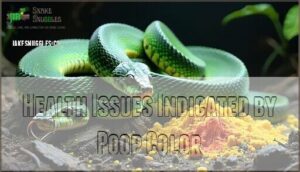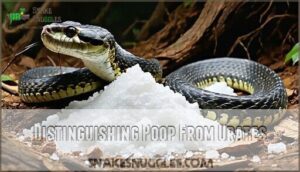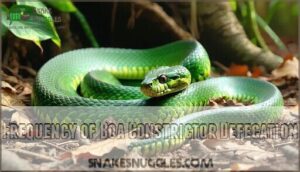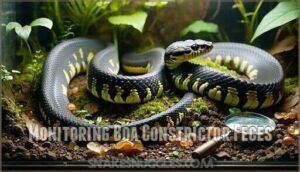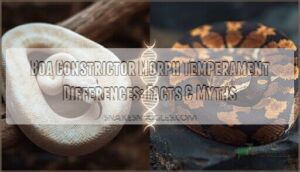This site is supported by our readers. We may earn a commission, at no cost to you, if you purchase through links.

Think of it like a health report card – normal boa constrictor pooping color tells you everything’s working smoothly inside.
You’ll also notice white chalky bits called urates mixed in, which is perfectly normal snake "urine."
However, if you spot bright red, yellow, or green waste, that’s your cue to call the vet immediately, as these dramatic color changes often signal parasites, infections, or digestive troubles that need professional attention.
Table Of Contents
- Key Takeaways
- Normal Boa Constrictor Feces Appearance
- Factors Affecting Boa Constrictor Poop Color
- Common Boa Constrictor Poop Colors
- Abnormal Boa Constrictor Poop Colors
- Health Issues Indicated by Poop Color
- Distinguishing Poop From Urates
- Frequency of Boa Constrictor Defecation
- Monitoring Boa Constrictor Feces
- Maintaining Healthy Digestion in Boa Constrictors
- Frequently Asked Questions (FAQs)
- What does boa constrictor poop look like?
- What color should snake poop be?
- How to tell if snake poop is healthy?
- Is it normal for snake poop to be white?
- What are the symptoms of impaction in snakes?
- What does it mean if your snakes poop is white?
- How long can a boa constrictor go without pooping?
- Does shedding influence boa constrictor feces appearance?
- Are there seasonal changes in boa constrictor poop color?
- Can stress alter the color of boa constrictor droppings?
- Conclusion
Key Takeaways
- You’ll typically see dark brown to black, firm, sausage-shaped droppings that are 2-6 inches long with white chalky urates alongside – this indicates healthy digestion and normal kidney function in your boa constrictor.
- You should immediately contact a vet if you spot bright red, yellow, or green waste, as these dramatic color changes often signal parasites, infections, liver problems, or internal bleeding that need professional attention.
- You can expect your boa to defecate once per meal, with younger snakes pooping every 5-7 days and adults going every 2-3 weeks – this frequency depends on their feeding schedule and environmental conditions like proper temperature and humidity.
- You’ll want to keep detailed records of your boa’s bathroom habits, tracking color, size, and frequency to spot health changes early and distinguish between normal variations and concerning warning signs.
Normal Boa Constrictor Feces Appearance
When you’re examining your boa’s waste, you’ll typically see dark brown to black, firm, sausage-shaped droppings that measure 2 to 6 inches long.
Healthy boa poop looks like a firm, dark chocolate sausage—nature’s perfect digestive success story.
You’ll also notice white chalky urates alongside the feces, which is completely normal and shows your snake’s kidneys are working properly.
Color
The typical boa constrictor poop color ranges from dark brown to black, like rich chocolate.
Your snake’s feces color depends on recent meals—rodents create darker droppings while birds produce lighter shades.
Prey pigmentation and your boa’s unique color genetics influence these natural variations.
Don’t worry about slight changes; consistent snake poop color signals healthy digestion.
Consistency
Beyond color, your boa constrictor poop consistency tells an important health story.
Healthy snake feces should feel firm and hold a solid log shape—think of it as nature’s perfectly formed sausage.
When dehydration strikes, you’ll notice dry, crumbly droppings that fall apart easily.
Watch for these consistency red flags:
- Mucus presence: Excessive slime coating suggests digestive upset
- Undigested food: Visible prey remains indicate poor digestion
Normal urates consistency appears chalky white, while dehydration signs include concentrated, hard urates alongside the main waste.
Size
The size of your boa constrictor poop directly reflects their meal size and snake age.
Feces length typically spans 2 to 6 inches, resembling a firm sausage.
Larger boas produce bigger dropping volume after consuming substantial prey size.
This reptile feces serves as your health barometer—consistent size indicates proper digestion.
When monitoring snake droppings, remember that boa constrictor poop should match recent feeding portions.
Factors Affecting Boa Constrictor Poop Color
Your boa’s poop color isn’t random—it’s actually influenced by several key factors you can control and monitor.
What your snake eats, how well it stays hydrated, and even its age all play important roles in determining whether you’ll see dark brown logs or something that makes you wonder if you should call the vet, considering factors such as what your snake eats.
Diet
Your boa’s diet directly affects boa constrictor poop color.
Prey type matters most—rodents create darker feces color, while birds produce lighter waste.
Prey size and feeding frequency also influence snake poop color.
Frozen vs. live prey can slightly alter digestion patterns.
A consistent boa constrictor diet promotes predictable snake digestion, making abnormal colors easier to spot.
Supplementation needs remain minimal with proper whole-prey feeding schedules.
Hydration
Your snake’s hydration levels directly impact boa constrictor poop appearance and snake poop color.
When dehydration strikes, you’ll notice darker, drier droppings with concentrated urates that look chalky and thick.
Proper hydration keeps everything flowing smoothly, preventing constipation and maintaining healthy urates consistency.
Monitor these key indicators:
- Water bowl cleanliness and easy access
- Enclosure humidity matching your snake’s needs
- Skin elasticity during the shedding cycle
Well-hydrated boas produce normal-colored waste and stay healthier overall, thanks to proper hydration.
Age
Your boa’s age dramatically influences its bathroom habits. Think of it like human development – babies need frequent diaper changes, while adults have more predictable schedules.
Hatchlings produce lighter-colored waste every few days, while senior digestion slows considerably. One key factor is that captive boas live longer due to consistent care.
These lifespan changes help you track your snake’s health and development stages. The age of your boa is crucial in understanding its waste production and overall well-being.
| Age Stage | Typical Color | Defecation Frequency |
|---|---|---|
| Hatchlings | Light brown to tan | Every 2-3 days |
| Juveniles | Medium brown | Every 4-6 days |
| Young Adults | Dark brown | Weekly |
| Mature Adults | Very dark brown/black | Every 7-10 days |
| Seniors | Variable darkness | Less predictable timing |
Common Boa Constrictor Poop Colors
You’ll typically see your boa’s waste in three main colors that signal normal, healthy digestion.
Brown and black droppings are the most common, while white chalky material called urates appears alongside the main waste.
Brown
Spotting brown boa constrictor poop means you’re witnessing Normal Variations in your snake’s Digestive Health.
This common snake poop color ranges from light to dark brown, influenced by Diet Influence and Hydration Impact.
Your boa constrictor produces these healthy-looking droppings when Consistency Factors align properly.
Think of brown snake waste as nature’s thumbs-up for good digestion.
Black
Moving beyond brown, black boa constrictor poop often catches owners off guard. Don’t panic – this color change usually stems from natural processes. Digested blood from prey creates darker waste, while melanin presence can deepen coloration. Your snake’s dietary influence plays a major role here.
The snake’s coloration, including base color variations, also plays a role.
However, not all black poop signals normalcy. Watch for these warning signs:
- Internal blockage causing persistent dark, hard droppings
- Activated charcoal-like texture indicating severe dehydration
- Black blood in stool appearing as tarry, sticky consistency
- Repeated black regurgitation paired with appetite loss
Snake poop color changes happen, but consistent black poop warrants attention. Think of it like your morning coffee – occasionally dark is fine, but if it’s always pitch black, something’s brewing that needs checking.
White
White snake poop color isn’t always what it seems.
Those chalky white chunks? They’re usually urates, not actual feces.
Think of urates as your boa’s version of pee – showing normal kidney function and mineral excretion.
However, true white boa constrictor poop signals digestive trouble. Dehydration signs include dry, concentrated urates, while dietary influence affects reptile poop color patterns.
Abnormal Boa Constrictor Poop Colors
When you spot red, yellow, or green in your boa’s waste, it’s time to pay attention because these colors often signal health problems that need your care.
While your snake’s usual brown droppings might seem boring, these colorful surprises can tell you important stories about infections, liver issues, or internal bleeding that require a vet’s help.
Red
Red stools from your boa constrictor can catch you off guard and signal serious trouble.
Red droppings aren’t just concerning—they’re your snake’s urgent cry for help.
This isn’t your typical digestion of blood from prey – it’s often fresh blood indicating internal bleeding or severe digestion issues.
When you spot red droppings or blood in poop, don’t wait around. Immediate action and veterinary attention are essential.
Your snake’s health depends on addressing these warning signs quickly.
Conversely, unusual colors like green might suggest a potential internal infection, warranting close observation.
Yellow
While red feces signal immediate concern, yellow droppings in your boa constrictor shouldn’t be ignored either.
This unusual coloration often points to liver function problems or gallbladder concerns that need attention. The yellow boa, scientifically known as Boa constrictor imperator, can be found in tropical regions.
Causes of yellow feces include:
- Prolonged fasting periods affecting bile production
- Liver issues disrupting normal digestive processes
- Diet imbalances creating metabolic stress
Diagnosis requires veterinary examination to rule out serious conditions. Treatment depends on the underlying cause, while Prevention involves maintaining consistent feeding schedules and proper nutrition. Don’t wait if yellow droppings persist.
Green
Unlike yellow feces, green poop in your boa signals potential trouble.
While green urates can be normal, green feces often indicates bacterial infections or gallbladder issues.
Dietary chlorophyll from prey can cause minor color changes, but persistent green suggests a stress response or infection.
Don’t ignore this warning sign—schedule a veterinary consultation immediately to rule out serious digestive problems before they worsen.
Health Issues Indicated by Poop Color
When your boa’s poop changes color, it’s often your first clue that something’s wrong with their health.
These color changes can signal serious problems like parasites, infections, or liver issues that need quick attention from a reptile vet, which can be considered quick attention.
Parasites
Parasites love to crash your boa’s digestive party, turning normal snake poop color into something concerning.
These unwelcome guests often announce their presence through unusual bowel movement changes that’ll make you do a double-take.
Internal parasites like nematodes and protozoa are especially sneaky troublemakers.
Here’s your parasite game plan:
- Watch for Warning Signs – Green, yellow, or bloody snake poop identification signals possible infection
- Prevention First – Clean enclosures and quarantine new snakes prevent most issues
- Professional Help – Veterinary diagnosis requires fecal testing for accurate identification
- Treatment Options – Prescription antiparasitic medications target specific snake parasites effectively
External parasites rarely affect fecal appearance directly.
Infections
Beyond parasites, bacterial infections can paint your boa’s waste in alarming colors.
Viral infections might cause subtle changes, while fungal infections create unusual textures. Protozoal infections often trigger diarrhea with green poop or yellow feces appearing frequently.
Your snake’s excrement color becomes a health barometer during illness. Bacterial infections from poor husbandry conditions show up fast.
Don’t ignore these snake poop color warnings—early infection treatment saves your serpent’s life and your wallet.
Liver Problems
While infections wreak havoc internally, liver problems show up differently in your boa constrictor’s waste. When bile production gets disrupted, you’ll notice pale or clay-colored feces instead of normal dark brown.
Yellowish droppings can signal jaundice signs, indicating your snake’s liver isn’t processing waste properly. Watch for these liver-related changes in snake excrement color:
- Consistently pale or clay-colored feces replacing normal dark waste
- Yellow-tinged droppings suggesting compromised liver enzymes
- Light-colored stools persisting across multiple bowel movements
Consult your reptile vet about treatment options immediately, as liver problems and compromised liver enzymes can have serious implications for your boa constrictor’s health.
Distinguishing Poop From Urates
You’ll often find both dark feces and white chalky material in your boa’s enclosure, but don’t worry—that white stuff isn’t weird-colored poop.
The white substance is called urate, which is your snake’s version of urine, and it’s completely normal to see it alongside the brown or black fecal matter.
Urate Appearance
When you’re cleaning your boa’s enclosure, those chalky white bits aren’t leftover calcium powder—they’re urates.
These kidney waste products have a distinctly different urate appearance from feces.
Normal urate colors range from bright white to slightly yellowish, with a paste-like consistency that’s softer than poop.
Urate volume varies based on your snake’s hydration levels and kidney function.
The urate composition creates an irregular, clumpy shape that’s much smaller than the elongated feces.
Dehydration effects can make urates more concentrated and darker.
Normal Urate Colors
Looking at what’s normal for urates, you’ll typically encounter three healthy color variations:
- Pure white – The gold standard indicating excellent hydration
- Pale yellow – Still within normal range, showing good kidney function
- Light beige – Another acceptable variation for some individual snakes
These normal urate colors appear chalky and distinct from darker snake poop.
White urates remain the most common healthy sign, while hydration’s urate effect directly influences consistency and pigmentation.
A healthy snake’s waste includes firm but not dry feces.
Frequency of Boa Constrictor Defecation
You’ll notice your boa doesn’t poop on a daily schedule like mammals do, but rather follows a pattern tied directly to their feeding routine.
Most healthy boas defecate once per meal, typically showing up about halfway between feedings.
This means you might see waste every 5-7 days for younger snakes or every 2-3 weeks for adults.
Feeding Schedule
Now that you understand what poop and urates look like, let’s talk about how your feeding schedule affects when your boa constrictor actually goes.
Your snake’s diet and feeding frequency directly control poop color and snake poop consistency.
Adult Schedule means feeding every 2-4 weeks, while Juvenile Schedule requires weekly meals.
Prey Size matters – bigger meals reduce Regurgitation Risk but create larger waste.
| Age Group | Feeding Frequency | Typical Prey Size |
|---|---|---|
| Juvenile | Every 5-7 days | Small rats/mice |
| Adult | Every 2-4 weeks | Large rats/rabbits |
| Senior | Every 4-6 weeks | Medium-large prey |
Environmental Factors
Beyond feeding schedules, your boa’s bathroom habits depend heavily on environmental factors.
Think of your snake’s enclosure as its personal spa – when conditions aren’t right, everything goes haywire.
Here’s what affects your boa’s digestive rhythm:
- Temperature Gradients – Cool spots slow digestion while proper heat keeps things moving
- Humidity Levels – Low humidity leads to dehydration and constipation
- Substrate Choice – Wrong bedding can cause impaction if ingested
- Enclosure Size – Cramped spaces create stress, disrupting normal bowel patterns
Getting these environmental factors right keeps your snake’s plumbing running smoothly.
Monitoring Boa Constrictor Feces
You’ll want to keep track of your boa’s bathroom habits like a detective solving a mystery—it’s one of the best ways to catch health problems early.
Start a simple log that records the color, size, and frequency of your snake’s droppings, and you’ll quickly learn what’s normal for your slithery friend.
Record Keeping
Your boa constrictor’s bathroom habits deserve a detective’s attention. Start tracking every bowel movement with precise record keeping to spot health changes early.
| Date | Color Variations | Fecal Consistency | Urates Presence |
|---|---|---|---|
| 6/15 | Dark brown | Firm, solid | White, chalky |
| 6/22 | Black-brown | Slightly soft | Yellowish-white |
| 6/29 | Light brown | Hard, dry | Bright white |
Document frequency tracking alongside dietary influence. For assistance, consider using a snake waste tracker to monitor your boa’s health. Your snake’s poop color patterns reveal digestive health better than any crystal ball.
When to Seek Veterinary Care
Recording your observations helps, but recognizing when your boa needs professional help matters more.
Watch for these warning signs that scream "vet visit now":
- Blood present in droppings alongside excessive mucus
- Persistent abnormalities in poop color lasting over 48 hours
- Red stools or green droppings with behavioral changes
- Appetite loss combined with abnormal fecal appearance
Don’t play guessing games with your snake’s health.
These symptoms often indicate serious infections or internal bleeding requiring immediate veterinary care.
Early intervention prevents minor issues from becoming life-threatening emergencies.
Regular checkups can help with early disease detection.
Maintaining Healthy Digestion in Boa Constrictors
You can prevent most digestive problems in your boa by feeding appropriately sized prey and maintaining proper temperature and humidity levels in their enclosure.
Think of it like creating a snake spa – when everything’s just right, your boa’s digestive system works like clockwork and produces those healthy brown droppings you want to see, which is the result of a well-functioning digestive system that can be achieved by maintaining the right environment, including proper temperature.
Proper Diet
Through proper diet choices, you’ll maintain your boa constrictor’s digestive health and normal poop color.
Balanced nutrition starts with appropriate prey size—roughly 10-15% of your snake’s body weight.
Feeding frequency matters too: juveniles eat weekly, adults every 2-3 weeks.
| Diet Factor | Recommendation |
|---|---|
| Prey Size | 10-15% of snake’s body weight |
| Feeding Frequency | Juveniles weekly, adults bi-weekly |
| Frozen vs. Live | Both acceptable when properly thawed |
| Supplementation Needs | Minimal with whole prey diet |
Consistent feeding schedules promote regular digestion and predictable waste patterns.
Many owners purchase prey from retailers for convenience, ensuring a whole prey diet with minimal supplementation needs.
Enclosure Conditions
Think of your boa’s enclosure as their personal spa – everything needs to be just right for proper digestion.
Maintain a temperature gradient with a basking spot at 88-92°F and a cool side at 78-82°F.
Humidity levels should stay between 50-60%, while your substrate choice affects moisture balance.
Enclosure size matters too – cramped quarters stress your snake.
A proper setup requires careful consideration of boa habitat products.
Essential elements include:
- A cozy hide that feels like a warm, snug retreat
- A water dish large enough for rejuvenating soaks
- Climbing branches for exploration and exercise
Hiding spots reduce stress, and water bowl cleanliness prevents bacterial growth that disrupts digestion.
Frequently Asked Questions (FAQs)
What does boa constrictor poop look like?
You’ll notice your boa’s poop looks dark brown to black with a firm, sausage-like shape. It’s typically 2-6 inches long and comes with white chalky urates alongside the main waste.
What color should snake poop be?
Your snake’s poop should be dark brown to black—that’s the healthy norm.
You’ll also see white chalky urates alongside it.
If you spot red, green, or yellow consistently, it’s time for a vet visit.
How to tell if snake poop is healthy?
A picture’s worth a thousand words" applies to snake droppings too.
You’ll spot healthy poop as firm, dark brown segments with white chalky urates alongside.
Watch for consistent texture, size, and that distinctive earthy smell, and note the importance of a picture in understanding these signs.
Is it normal for snake poop to be white?
White parts in your snake’s droppings are completely normal.
They’re called urates – basically reptile urine that’s chalky and white.
You’ll often see them alongside the darker feces, indicating healthy kidney function.
What are the symptoms of impaction in snakes?
You’ll notice your snake struggling to defecate, showing swollen belly areas, loss of appetite, and lethargy.
They might also display unusual postures while attempting to pass waste, with visible discomfort during movement, which can be a clear sign of lethargy.
What does it mean if your snakes poop is white?
If you’re seeing chalky white material in your snake’s waste, that’s likely urates – their version of urine.
It’s completely normal!
However, if the entire poop is white, check for digestive issues.
How long can a boa constrictor go without pooping?
Your patience could outlast eternity waiting for your boa’s bathroom break.
You can expect your snake to go 2-4 weeks without pooping, especially after big meals.
Don’t panic—this lengthy schedule’s totally normal.
Does shedding influence boa constrictor feces appearance?
Yes, shedding does influence your boa’s feces appearance. During the shedding process, your snake’s digestive system slows down, often making their droppings darker, drier, and more concentrated than usual.
Are there seasonal changes in boa constrictor poop color?
Ironically, while you’re tracking every bathroom visit, your boa’s poop color doesn’t dramatically shift with seasons.
Temperature changes might slightly affect digestion timing, but diet and health matter more than calendar months.
Can stress alter the color of boa constrictor droppings?
Stress can definitely change your boa’s poop color temporarily.
When they’re anxious from handling, environmental changes, or other stressors, you’ll notice their droppings might look different than usual until they settle down again.
Conclusion
Monitoring your boa constrictor pooping color isn’t just good pet care—it’s your snake’s silent way of communicating its health status.
From normal brown shades to concerning reds and yellows, each color change tells a story about what’s happening inside your pet’s digestive system.
By keeping detailed records and understanding these visual cues, you’ll catch potential problems early and guarantee your boa stays healthy.
Remember, when in doubt about unusual colors, your veterinarian’s expertise is invaluable.
- https://www.peteducation.com/article.cfm?c=17+1797&aid=2688
- https://azeah.com/reptiles-amphibians/recognizing-abnormal-feces-reptiles
- https://blogs.ucl.ac.uk/researchers-in-museums/2016/11/09/question-of-the-week-how-do-snakes-poop/
- https://pethelpful.com/reptiles-amphibians/Common-Health-Problems-Snakes
- http://mailto:cenglish

